
5/4/2015
ENDOCRINE FUNCTION
OF THE REPRODUCTIVE
SYSTEM
By pharmacist
Maha A. Hamdi
Male reproductive endocrine
•
Testes
•
Interstitial cells secrete androgens
•
Primary androgen is testosterone
•
Maintains secondary sex characteristics
•
Helps promote sperm formation

5/4/2015
•
19
the principal hormone of the testes, is a C
Testosterone,
steroid with an –OH group in the 17 position.
•
It is synthesized:
•
1-from cholesterol in the Leydig cells
•
2- and from androstenedione secreted by the adrenal
cortex.

5/4/2015
massenger
nd
2
•
The secretion of testosterone is under the control of LH,
and the mechanism by which LH stimulates the Leydig
cells involves increased formation of cAMP via the G
s
G
coupled LH receptor and
-
protein
Transport & Metabolism
•
98% of the testosterone in plasma is bound to protein
called gonadal steroid-binding globulin (GBG) or sex
steroid-binding globulin,
•
33% to albumin
•
The plasma testosterone level (free and bound) is
•
300 to 1000 ng/dL (10.4–34.7 nmol/L) in adult men ,
•
30 to 70 ng/dL (1.04–2.43 nmol/L) in adult women.
•
It declines somewhat with age in males.

5/4/2015
•
A small amount of circulating testosterone is converted to
estradiol,
•
but most of the testosterone is converted to
•
17-ketosteroids, principally androsterone and its isomer
etiocholanolone and excreted in the urine
Actions
•
1-give Secondary Sex Characteristics
•
2-Anabolic Effects:
•
A-increase the synthesis
•
B- decrease the breakdown of protein,
•
–
4
, and PO
–
4
, SO
+
2
O, Ca
2
, H
+
, K
+
cause moderate Na
-
C
retention;
•
D-increase the size of the kidneys.

5/4/2015
Mechanism of Action
•
testosterone binds to an intracellular receptor, and the
receptor–steroid complex then binds to DNA in the
nucleus, facilitating transcription of various genes.
•
In addition, testosterone is converted to
dihydrotestosterone (DHT) by 5-reductase ,in some
target cells and DHT binds to the same intracellular
receptor as testosterone.
Steroid Feedback
•
Testosterone inhibits LH secretion by acting directly on
the anterior pituitary and by inhibiting the secretion of
GnRH from the hypothalamus.
•
Inhibin (from sertoli cells) acts directly on the anterior
pituitary to inhibit FSH secretion.
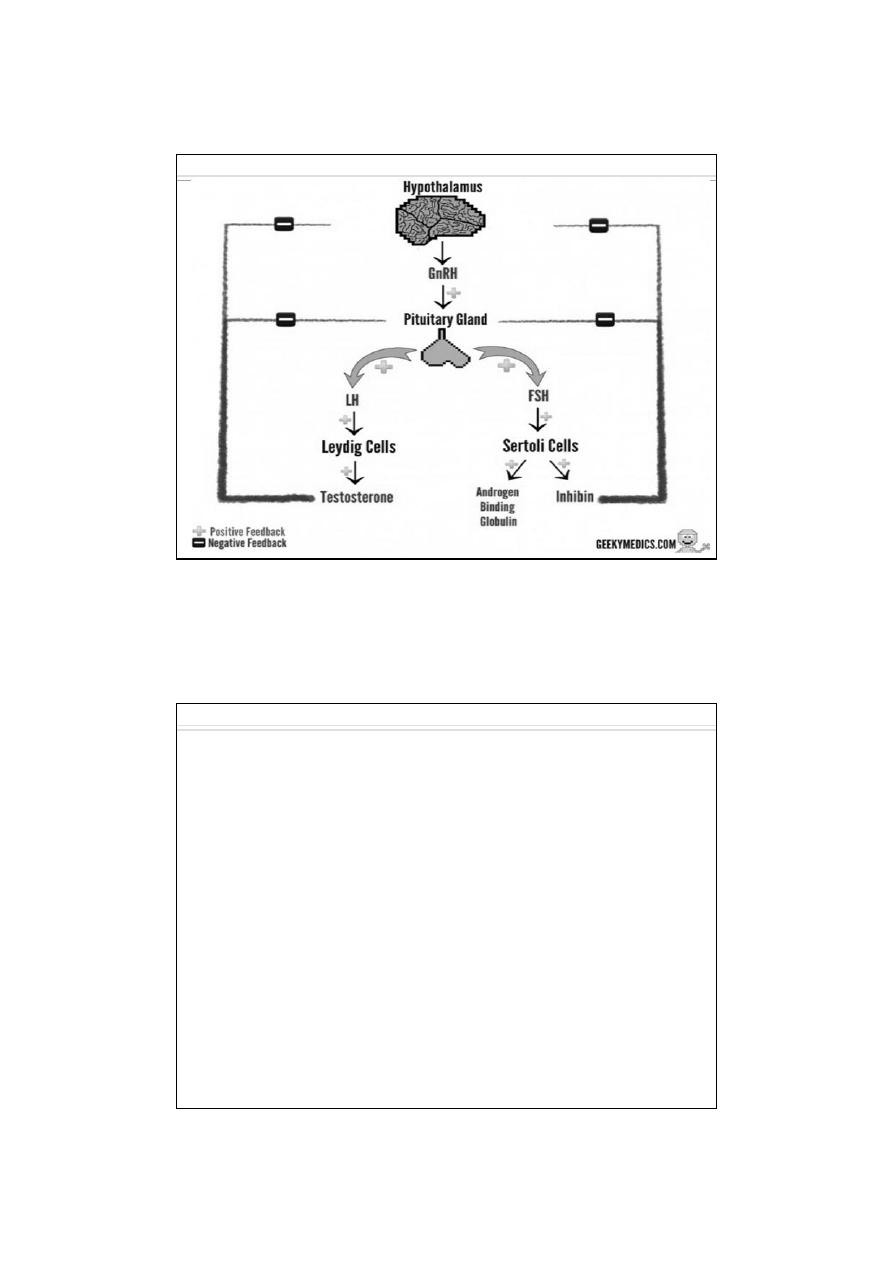
5/4/2015
Female Hormonal System
•
Ovaries
•
Androgens secreted by thecal folliculi
•
Directly converted to estrogens by follicular
granulosa cells
•
Granulosa cells also produce progesterone
•
Corpus luteum also secretes estrogen and
progesterone
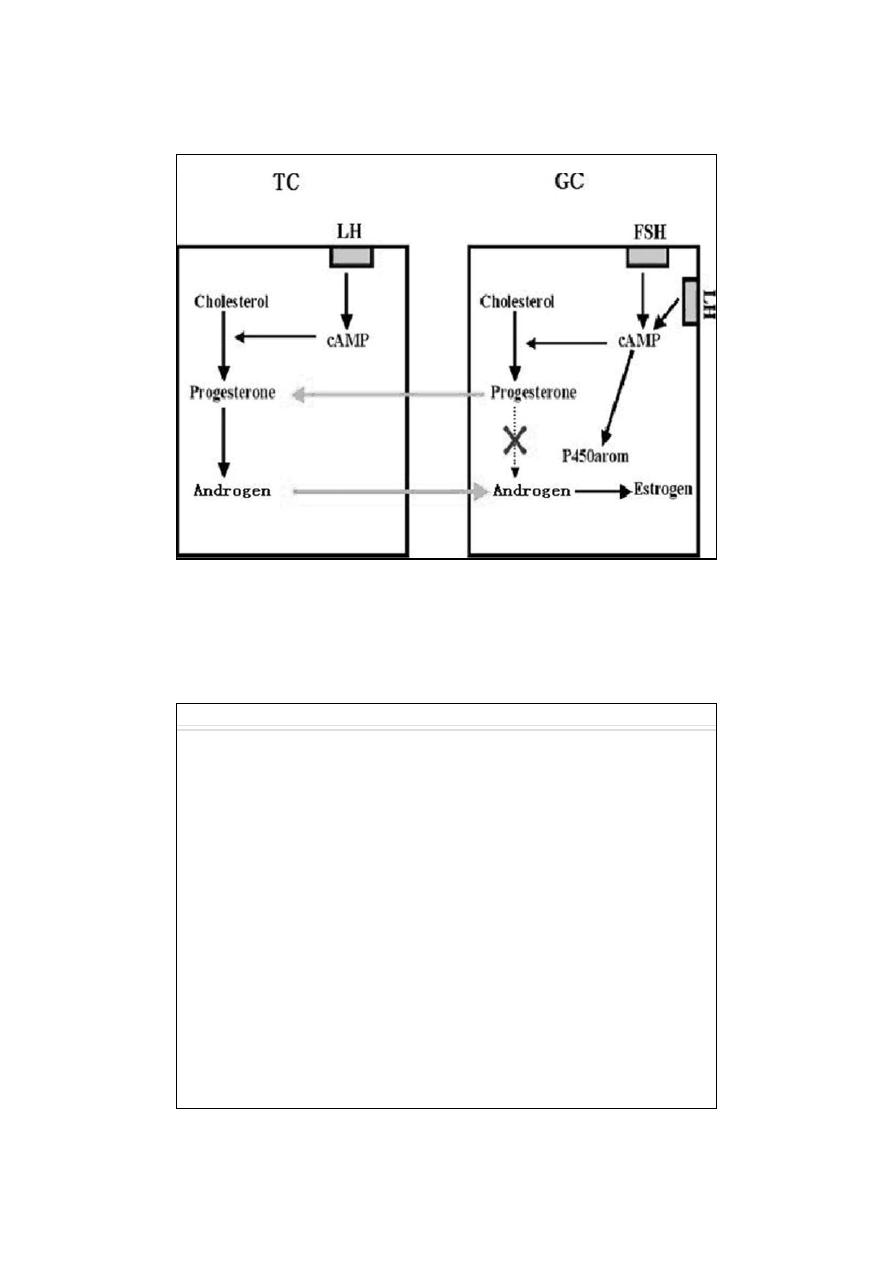
5/4/2015
Female Hormonal System
•
1-hypothalamic releasing hormone, gonadotropin-
releasing hormone (GnRH)
•
2-The anterior pituitary sex hormones, follicle-stimulating
hormone (FSH) and luteinizing hormone (LH), both of
which are secreted in response to the release of GnRH
from the hypothalamus
•
3-The ovarian hormones, estrogen and progesterone,
which are secreted by the ovaries in response to the two
female sex hormones from the anterior pituitary gland
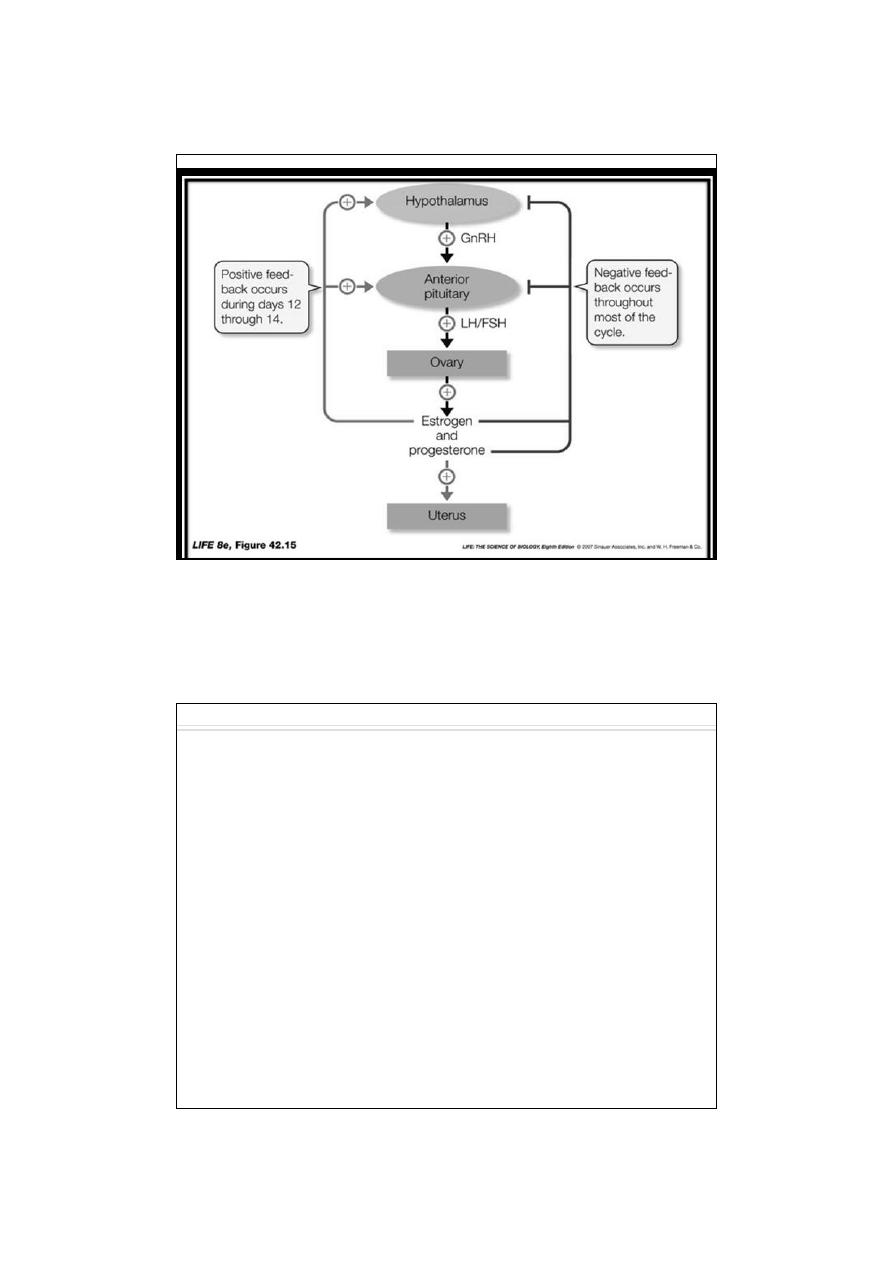
5/4/2015
•
The ovarian changes that occur during
the sexual cycle depend completely on
the gonadotropic hormones FSH and
LH, secreted by the anterior pituitary
gland.

5/4/2015
•
Both FSH and LH are small glycoproteins
having molecular weights of about 30,000.
•
During each month of the female sexual
cycle, there is a cyclical increase and
decrease of both FSH and LH
•
Both FSH and LH stimulate their ovarian target
cells by combining with highly specific FSH and
LH receptors in the ovarian target cell
membranes.
•
the activated receptors ↑the cells' rates of
secretion and usually the growth and proliferation
of the cells as well.
•
Almost all these stimulatory effects result from
activation of the cAMP second messenger
system in the cell cytoplasm, which causes the
formation of Pk &multiple phosphorylations of key
enzymes that stimulate sex hormone synthesis
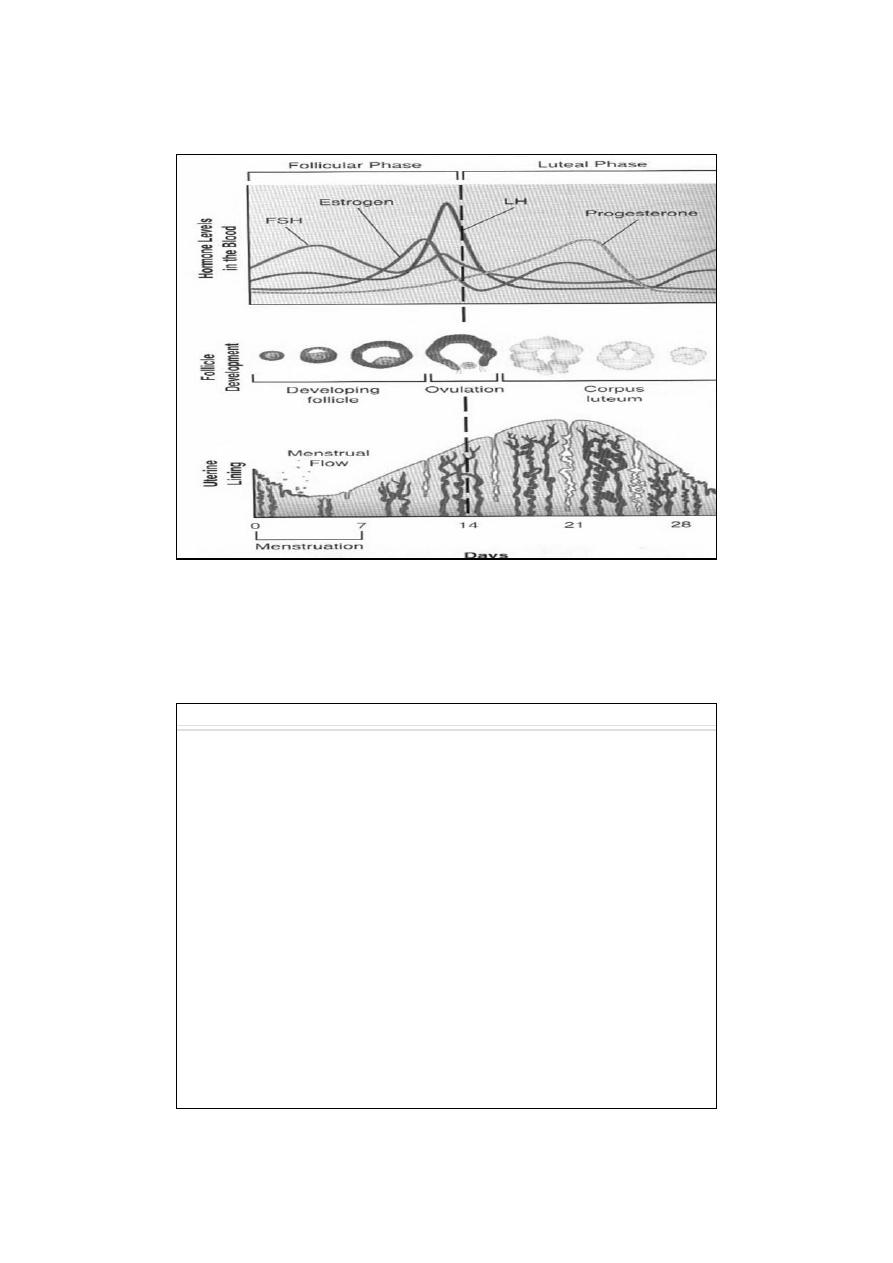
5/4/2015
•
1-FSH, cause accelerated growth of 6 to 12
primary follicles each month.
•
2-Estrogen is secreted into the follicle and causes
the granulosa cells to form increasing numbers of
FSH receptors.
•
3-The pituitary FSH and estrogens combine to
promote LH receptors on the original granulosa
cells, thus allowing LH stimulation to occur in
addition to FSH stimulation

5/4/2015
•
4- The increasing estrogens from the follicle plus
the increasing LH from the anterior pituitary gland
act together to cause proliferation of the follicular
thecal cells and increase their secretion.
•
5- 2 days before ovulation , LH ↑, rising 6- to 10-
fold and peaking about 16 hours before ovulation.
•
6-FSH ↑about 2 -3 folds at the same time,
•
7- the rate of secretion of estrogen begins to ↓ 1
day before ovulation, while increasing amounts of
progesterone begin to be secreted.
•
8- ovulation occur at day 12 of the cycle.
•
9- after expulsion of the ovum from the follicle,
the remaining granulosa and theca interna cells
change rapidly into lutein cells (luteinization).
•
10- corpus luteum form large amounts of
progesterone and estrogen .
•
11- if pregnancy occur, chorionic gonadotropin
(like LH action), secreted by placenta, act on
corpus luteum to prolong its life for at least the
first 2 to 4 months of pregnancy .
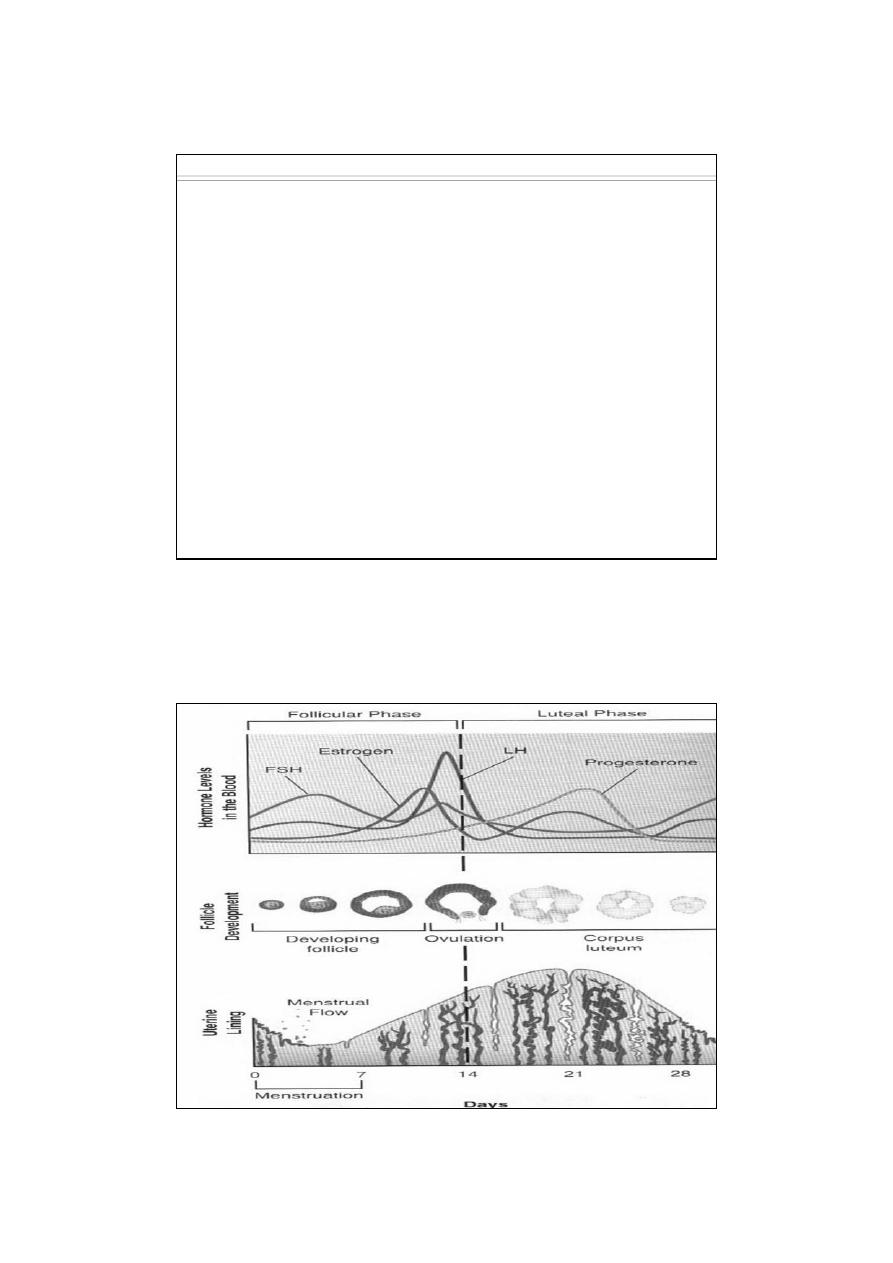
5/4/2015
•
12-,Estrogen& progesterone, secreted by the corpus
luteum, have strong feedback effects on the anterior
pituitary gland to maintain low rates of FSH and LH.
•
13- the lutein cells secrete small amounts of the hormone
inhibin inhibits secretion by the anterior pituitary gland,
especially FSH .
•
14- low LH & FSH → degeneration of corpus leutum
(involution).
•
15 -sudden cessation of secretion of estrogen,
progesterone, and inhibin by the corpus luteum removes
the feedback inhibition of the anterior pituitary gland
→begin to ↑ secreting of FSH and LH beginning a new
ovarian cycle.

5/4/2015
Functions of the Ovarian Hormones-
Estradiol and Progesterone
•
The two types of ovarian sex hormones are the
estrogens and progestins.
•
Estrogens responsible for the development of
secondary sexual characteristics of the female.
•
progestins function mainly to prepare the uterus
for pregnancy and the breasts for lactation.
Ovarian Hormones
•
In the normal nonpregnant female, estrogens are
secreted in significant quantities only by the
ovaries.
•
During pregnancy, tremendous quantities of
estrogens are also secreted by the placenta.
•
Other naturally occurring estrogens are
•
17-estradiol, estrone, and estriol.
•
β-estradiol is considered the major estrogen,

5/4/2015
Ovarian Hormones
•
the most important of the progestins is
progesterone,&
•
17-α-hydroxyprogesterone.
•
But progesterone is the only important progestin.
•
progesterone is secreted in significant amounts
only during the latter half of each ovarian cycle,
when it is secreted by the corpus luteum.
•
estrogens and progesterone are transported in
the blood bound mainly with plasma albumin and
with specific estrogen- and progesterone-binding
globulins.
•
The binding between these hormones and the
plasma proteins is loose →rapidly released to the
tissues over a period of 30 min..

5/4/2015
metabolism
•
In the liver, estradiol, estrone, and estriol are
converted to glucuronide and sulfate conjugates.
•
All these compounds, along with other
metabolites, are excreted in the urine.
•
Appreciable amounts are secreted in the bile and
reabsorbed into the bloodstream (enterohepatic
circulation).
Effects of estrogen
•
1-development of female sex organs.
•
2- development of breasts.
•
3- inhibit osteoclastic activity in the bones and stimulate
bone growth &cause uniting of the epiphyses with the
shafts of the long bones.
•
4- cause a slight increase in total body protein.
•
5- Increase Body Metabolism and Fat Deposition .
•
6- cause the skin to develop a texture that is soft and
usually smooth.
•
7- cause sodium and water retention by the kidney
tubules.

5/4/2015
Functions of Progesterone
•
1- Promotes Secretory Changes in the Uterus , preparing
the uterus for implantation of the fertilized ovum.
•
2-Promotes Development of the Breasts .

5/4/2015
Female Monthly Rhythm-Interplay
Between the Ovarian and Hypothalamic-
Pituitary Hormones
•
The hypothalamus secrete GnRH in pulses lasting 5 to 25
minutes that occur every 1 to 2 hours.
•
The pulsatile release of GnRH also causes intermittent
output of LH secretion about every 90 minutes.
Feed back mechanism
•
Estrogen in small amounts has a strong effect to inhibit
the production of both LH and FSH.
•
feedback effects mainly on the anterior pituitary gland
directly, but also operate to a lesser extent on the
hypothalamus to ↓secretion of GnRH, especially by
altering the frequency of the GnRH pulses.
•
Inhibin has the same effect in the female &male-inhibiting
the secretion of FSH and, LH by the anterior pituitary.

5/4/2015
Feed back mechanism
•
feedback
positive
a
cycle has
of the
half
st
1
at
estrogen
effect of stimulating pituitary secretion of LH and,FSH.
•
sharp contrast to its normal(estrogen) negative feedback
effect that occurs during the remainder of the female
monthly cycle.
Feedback Oscillation of the Hypothalamic-
Pituitary-Ovarian System
•
1- during the postovulatory phase-between ovulation and
the beginning of menstruation, corpus luteum secretes
large quantities of progesterone ,estrogen, & inhibin,all
have a combined negative feedback effect on the anterior
pituitary and hypothalamus, causing the suppression of
both FSH and LH secretion and decreasing them to their
lowest levels about 3 to 4 days before the onset of
menstruation.

5/4/2015
Feedback Oscillation of the Hypothalamic-
Pituitary-Ovarian System
•
2- when menstruation begins, pituitary secretion of FSH
begins to increase , then, several days after menstruation
begins, LH secretion increases slightly , These hormones
initiate new ovarian follicle growth and a progressive
increase in the secretion of estrogen, reaching a peak
estrogen secretion at about 12.5 to 13 days ,during that
time the rates of pituitary secretion of the gonadotropins
FSH and LH decrease slightly because of the negative
feedback effect, of estrogen, Then a sudden, increase in
the secretion of LH and, FSH.
Feedback Oscillation of the Hypothalamic-
Pituitary-Ovarian System
•
3- About 11½ to 12 days after the onset of the monthly
cycle, the decline in secretion of FSH and LH , the high
level of estrogens at this time (or the beginning of
progesterone secretion by the follicles) causes a positive
feedback stimulatory effect on the anterior pituitary, which
leads to ↑LH and, FSH.
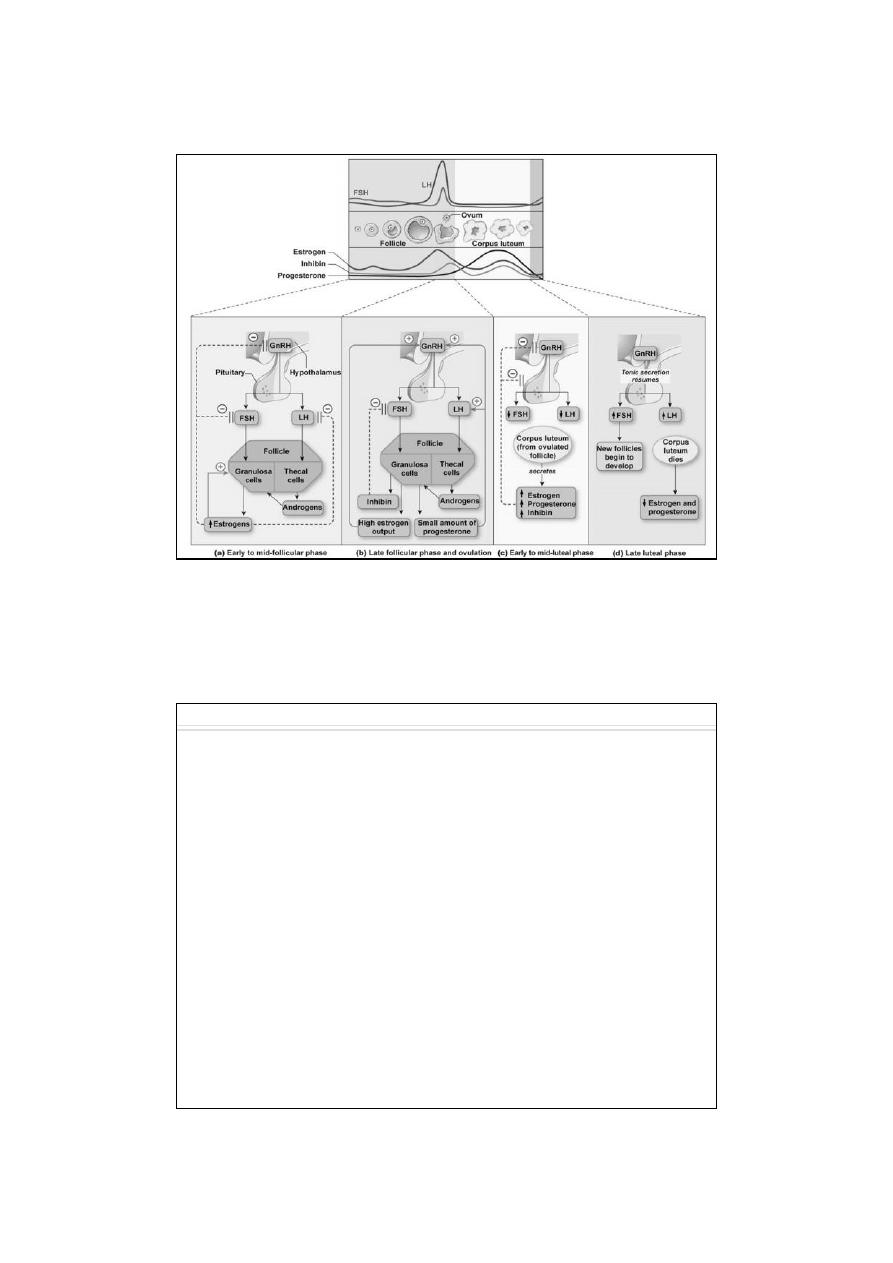
5/4/2015
Prolactin Promotes Lactation
•
This hormone is secreted by the mother's anterior pituitary
gland, and its concentration in her blood rises steadily
from the fifth week of pregnancy until birth of the baby.
•
the placenta secretes large quantities of human chorionic
somatomammotropin, which probably has lactogenic
properties.
•
secretion of milk requires an adequate background
secretion of most of the mother's other hormones as well,
but most important are growth hormone, cortisol,
parathyroid hormone, and insulin.
•
These hormones are necessary to provide the amino
acids, fatty acids, glucose, and calcium required for milk
formation.

5/4/2015
•
After birth of the baby, the basal level of prolactin
secretion returns to the nonpregnant level over the next
few weeks.
•
each time the mother nurses her baby, nervous signals
from the nipples to the hypothalamus cause a 10- to 20-
fold surge in prolactin secretion that lasts for about 1 hour.
•
hypothalamus plays an essential role in controlling
prolactin secretion.
•
hypothalamus mainly stimulates production of all the other
hormones, but it mainly inhibits prolactin production, This
factor is called prolactin inhibitory hormone.
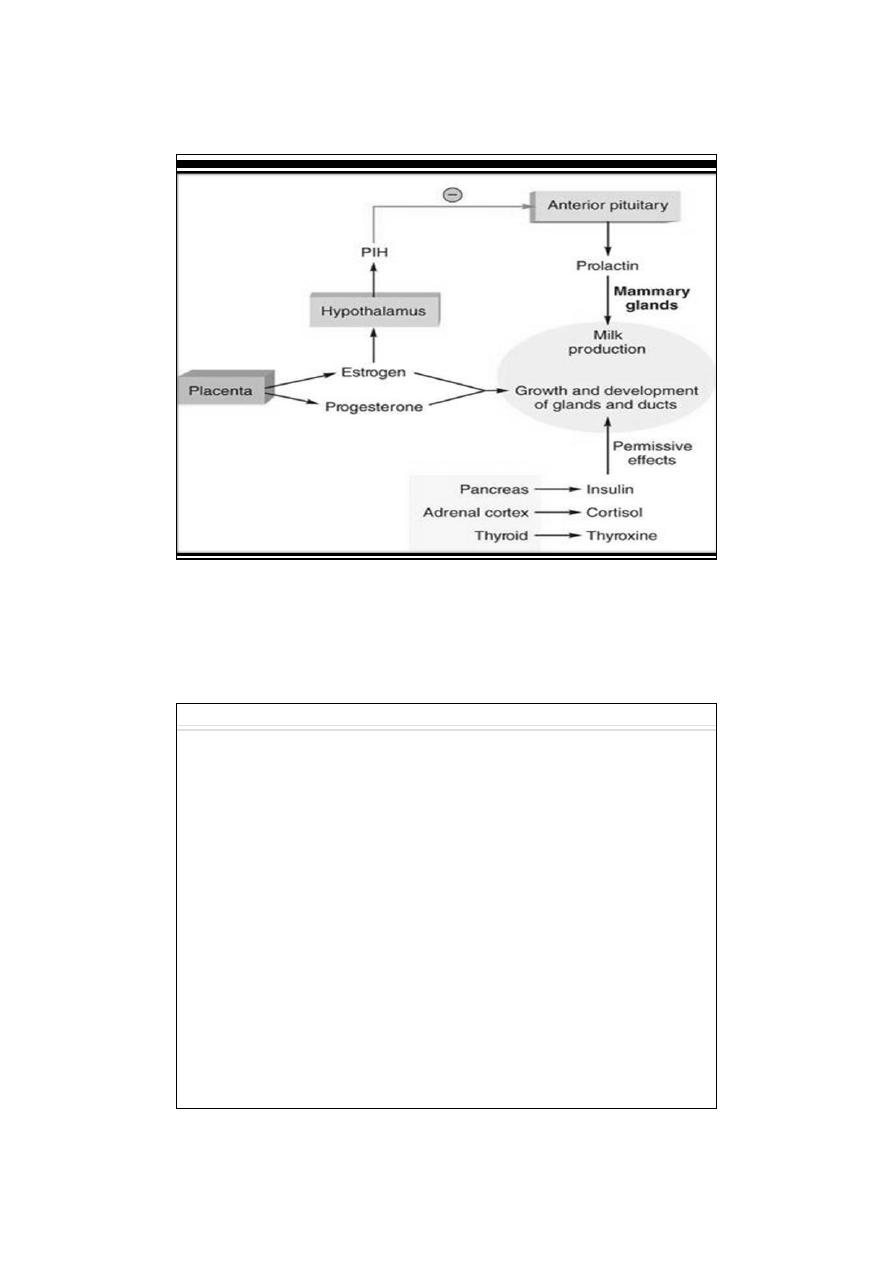
5/4/2015
Ejection (or "Let-Down") Process in Milk
Secretion-Function of Oxytocin
•
When the baby suckles, it receives virtually no milk for the
first half minute or so.
•
Sensory impulses must first be transmitted through
somatic nerves from the nipples to the mother's spinal
cord and then to her hypothalamus, where they cause
nerve signals that promote oxytocin secretion at the same
time that they cause prolactin secretion

5/4/2015
Inhibition of Milk Ejection
•
A particular problem in nursing a baby comes from the
fact that many psychogenic factors or even generalized
sympathetic nervous system stimulation throughout the
mother's body can inhibit oxytocin secretion and
consequently depress milk ejection.
•
For this reason, many mothers must have an undisturbed
period of adjustment after childbirth if they are to be
successful in nursing their babies.
